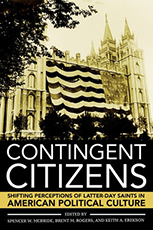
Contingent Citizens
Shifting Perceptions of Latter-day Saints in American Political Culture
Contingent Citizens features fourteen essays that track changes in the ways Americans have perceived the Latter-day Saints since the 1830s. From presidential politics, to political violence, to the definition of marriage, to the meaning of sexual equality—the editors and contributors place Latter-day Saints within larger American histories of territorial expansion, religious mission, Constitutional interpretation, and state formation. These essays also show that the political support of the Latter-day Saints has proven valuable to other political groups at critical junctures.
“Contingent Citizens moves beyond ecclesiastical history, and is much more than a book about Mormon church history.”
—John Fea, Messiah College
“This book edited by McBride, Rogers, and Erekson makes an important contribution to understanding the place of Mormonism in US history.”
—Amanda Porterfield, Florida State University
TABLE OF CONTENTS
Introduction. Not Exceptional, Typical, or Americanized: The Latter-day Saint Experience with American Politics by Keith A. Erekson
Part I: Authority and Mobilization
- “Some Little Necromancy”: Politics, Religion, and the Mormons, 1829–1838 by Adam Jortner
- “Many Think This Is a Hoax”: The Newspaper Response to Joseph Smith’s 1844 Presidential Campaign by Spencer W. McBride
- Precarious Protestant Democracy: Mormon and Catholic Conceptions of Democratic Rule in the 1840s by Benjamin E. Park
- “The Woman’s Movement Has Discovered a New Enemy—the Mormon Church”: Church Mobilization against the ERA and the NOW’s Countermobilization in Utah by Natalie K. Rose
Part II: Power and Sovereignty
- “The Way of the Transgressor Is Hard”: The Black Hawk and Mormon Wars in the Construction of Illinois Political Culture, 1832–1846 by Amy S. Greenberg
- “Like a Swarm of Locusts”: Perceptions of Mormon Geopolitical Power in a Non-US West, 1844–1848 by Thomas Richards Jr.
- “In the Style of an Independent Sovereign”: Mid-Nineteenth-Century Mormon Martial Law Proclamations in American Political Culture by Brent M. Rogers
- Political Perceptions of Mormon Polygamy and the Struggle for Utah Statehood, 1847–1896 by Stephen E. Smith
- A Snake in the Sugar: Magazines, the Hardwick Committee, and the Utah-Idaho Sugar Company, 1910–1911 by Matthew C. Godfrey
Part III: Unity and Nationalism
- “Rather Than Recognize This Wretched Imposture”: Edward Everett, Rational Religion, and the Territory of Utah/Deseret by Matthew Mason
- Ambiguous Allegiances and Divided Sovereignty: Mormons and Other Uncertain Americans in Nineteenth-Century North America by Rachel St. John
- Mormons at Midcentury: “Crushed Politically, Curtailed Economically,” but Winning “Universal Respect for Their Devotion and Achievements” by J. B. Haws
- The Historic Conflicts of Our Time: Ezra Taft Benson and Twentieth-Century Media Representations of Latter-day Saints by Patrick Q. Mason
BUY THE BOOK
PUBLICITY

